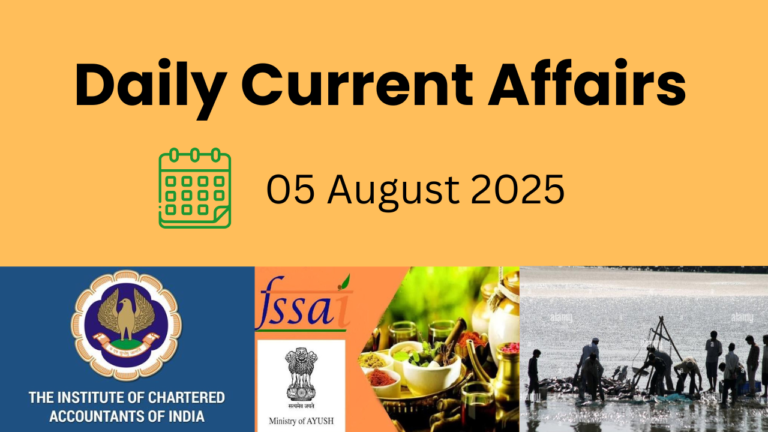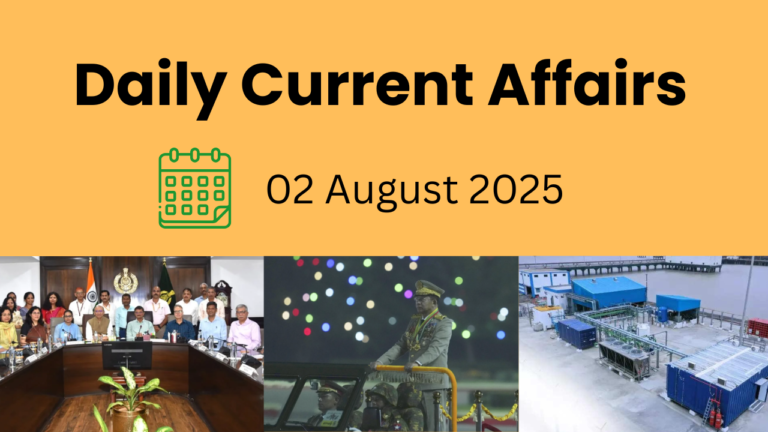1. NITI Aayog Launches India Electric Mobility Index to Accelerate State-Level EV Growth
Context: To fast-track India’s transition to clean and sustainable transport, NITI Aayog has launched the first edition of the India Electric Mobility Index (IEMI). This index is designed to evaluate and rank states and Union Territories (UTs) based on their performance in promoting electric vehicles (EVs) across key parameters like policy support, infrastructure, adoption rates, and ecosystem development.
The launch of the index marks a milestone in India’s EV journey, offering a standardized tool to measure progress and push for accountability and healthy competition among states.
Details:
What is the India Electric Mobility Index (IEMI)?
The India Electric Mobility Index 2023 is a performance-based tool developed to assess how different states are contributing to India’s EV mission. It aims to bring transparency and structure into evaluating the effectiveness of EV policies at the sub-national level.
Who developed the index?
The index is prepared by NITI Aayog in collaboration with RMI India, a research institute that works on clean energy and mobility. It combines government data, private sector inputs, and field research to offer a comprehensive comparison across states.
Purpose of the Index
- To provide a data-driven tool for states to measure and improve their EV ecosystem.
- To identify gaps and challenges in state-level EV policies and infrastructure.
- To guide policymakers and investors toward high-performing and high-potential regions.
- To encourage peer learning among states by showcasing successful models.
Key Parameters Considered
- EV adoption rates and share in total vehicle registrations.
- Availability and density of charging infrastructure.
- Presence and strength of EV manufacturing and supply chains.
- Quality and execution of state-level EV policies.
- Investments in R&D, innovation, and workforce training in the EV space.
Why this index matters
India has set ambitious goals under its National Electric Mobility Mission, including 30 percent EV penetration in private cars and up to 80 percent in two- and three-wheelers by 2030. Since implementation depends largely on state-level efforts, having a national index helps drive accountability and coordination.
Moreover, with increasing investments in the EV sector, this index provides valuable guidance to both public and private stakeholders for better planning and execution.
Conclusion:
The launch of the India Electric Mobility Index is a forward-looking step by NITI Aayog that reflects India’s commitment to cleaner transport and responsible policymaking. By offering a transparent and comparative view of how states are performing in the EV space, the index not only promotes healthy competition but also helps channel resources where they are most needed.
As India moves toward its climate goals and net-zero commitments, tools like this will play a crucial role in supporting data-driven decision-making, policy refinement, and focused implementation. It marks a new era of structured, state-led contribution to building a sustainable and inclusive electric mobility future.
2. NMPB Signs MoUs to Strengthen Conservation of Medicinal Plants
Context: In a significant step to promote the scientific conservation and sustainable use of medicinal plants, the National Medicinal Plants Board (NMPB) has signed three separate Memorandums of Understanding (MoUs) with the Ish Ved Bioplants venture, the All India Institute of Ayurveda (AIIA), and the All India Institute of Medical Sciences (AIIMS).
This collaboration is part of the government’s larger goal of integrating traditional medicine with modern science, while ensuring the protection and proper utilization of India’s rich biodiversity of medicinal plants.
Details
What is NMPB?
The National Medicinal Plants Board (NMPB) operates under the Ministry of AYUSH. It is responsible for promoting policies, programs, and activities related to the conservation, cultivation, and sustainable use of medicinal plants across India.
About the MoUs
- With Ish Ved Bioplants Venture
- Focus: Research and development of plant propagation techniques using biotechnology.
- Aim: To support mass multiplication of threatened medicinal plants through tissue culture and other methods.
- Outcome: Ensures availability of rare medicinal plants for both conservation and commercial use.
- With AIIA (All India Institute of Ayurveda)
- Focus: Creating scientific documentation and validation of traditional Ayurvedic formulations.
- Aim: To develop evidence-based standards for the use of medicinal plants in Ayurveda.
- Outcome: Bridges the gap between ancient knowledge and modern medical research.
- With AIIMS (All India Institute of Medical Sciences)
- Focus: Integrating modern medical research with the therapeutic properties of medicinal plants.
- Aim: To support clinical trials, phytochemical studies, and pharmacological research.
- Outcome: Promotes interdisciplinary cooperation for creating a modern, science-backed herbal healthcare system.
Why this collaboration matters
- India is home to over 7,500 species of medicinal plants, many of which are endangered due to overharvesting and habitat loss.
- These MoUs aim to combine traditional wisdom with scientific innovation to make medicinal plant use sustainable and safe.
- The initiative also supports the goals of the National AYUSH Mission, Digital India, and Atmanirbhar Bharat, by encouraging local cultivation, clinical validation, and value-added products.
Role in global markets
- The global demand for herbal and plant-based medicines is rapidly increasing.
- With standardized research and documentation, India can become a leading global supplier of high-quality medicinal plants and Ayurvedic products.
Conclusion: The MoUs signed by the National Medicinal Plants Board with Ish Ved Bioplants, AIIA, and AIIMS reflect a strong commitment to preserving India’s traditional knowledge while advancing modern scientific standards. These partnerships will not only strengthen the conservation of rare medicinal plants but also help in developing evidence-based herbal medicine, creating new opportunities in healthcare, research, and rural employment.
By uniting biotechnology, Ayurveda, and allopathic research under a common goal, the government is setting the foundation for a holistic, sustainable, and globally competitive medicinal plant ecosystem. This is a timely and visionary step toward building a healthier and self-reliant India.
3. Punjab Becomes First State to Appoint Language Experts under Juvenile Justice Act
Context: In a progressive move toward ensuring inclusive justice for children, Punjab has become the first state in India to officially empanel language interpreters and translators under the Juvenile Justice (Care and Protection of Children) Act, 2015.
This step reflects the state’s commitment to strengthening child-friendly legal procedures, especially for children who may face language barriers or communication difficulties when involved in legal cases, either as victims, witnesses, or in conflict with the law.
Details
Empanelment refers to the official registration and listing of qualified professionals, in this case, language interpreters and translators, who can assist children in navigating the juvenile justice system. These experts will now be available on call across districts whenever the need arises in child welfare committees, juvenile courts, police stations, and shelter homes.
Why is this important?
Children in the juvenile system often come from diverse linguistic, regional, and educational backgrounds. Some may:
- Not understand the official language used in legal proceedings.
- Be hearing- or speech-impaired.
- Have limited comprehension skills due to trauma or age.
Without proper interpretation or translation, their right to fair hearing and participation in the process can be severely compromised. Punjab’s initiative ensures that no child is left unheard due to a language barrier.
Implementation mechanism
- The interpreters and translators have been empaneled under the Punjab State Child Protection Society (PSCPS).
- The initiative is in accordance with Section 26 of the Juvenile Justice Act, 2015, which mandates the provision of interpreters, translators, special educators, and experts to assist children during inquiry or proceedings.
- Training and sensitization sessions will be conducted to ensure these professionals understand how to communicate with children effectively and ethically.
Broader impact
- Promotes child-sensitive justice systems.
- Ensures compliance with national child rights laws and international frameworks like the UN Convention on the Rights of the Child.
- Sets a model for other Indian states to follow, encouraging them to build similar support systems for children in the legal process.
Conclusion: With this decision, Punjab has taken a landmark step in making the juvenile justice system more accessible and child-friendly. By empanelling language interpreters and translators, the state has acknowledged a critical but often overlooked aspect of justice—the right to understand and be understood.
This move ensures that all children, regardless of language, ability, or background, can engage meaningfully in legal proceedings and receive the protection and support they deserve. It also reaffirms India’s growing emphasis on human rights-based legal reforms and the creation of a more inclusive justice delivery system.
4. India Hosts First BIMSTEC Traditional Music Festival in New Delhi
Context: In a celebration of shared cultural heritage and regional unity, India hosted the first-ever BIMSTEC Traditional Music Festival in New Delhi, inaugurated by External Affairs Minister Dr. S. Jaishankar. The event brought together musical traditions from across the Bay of Bengal Initiative for Multi-Sectoral Technical and Economic Cooperation (BIMSTEC) member countries, highlighting the importance of cultural diplomacy in regional cooperation.
This festival marks a milestone in strengthening people-to-people ties, enhancing soft power, and using culture as a tool for regional harmony and integration.
Details
What is BIMSTEC?
BIMSTEC is a regional organization comprising seven countries:
- Bangladesh
- Bhutan
- India
- Myanmar
- Nepal
- Sri Lanka
- Thailand
It was established in 1997 to promote technical and economic cooperation among countries bordering the Bay of Bengal. Over time, BIMSTEC has expanded to include areas like connectivity, energy, counter-terrorism, and now, cultural collaboration.
About the Music Festival
- Venue: New Delhi
- Organized by: Indian Council for Cultural Relations (ICCR) in coordination with the Ministry of External Affairs
- Theme: Celebration of traditional music and cultural unity among BIMSTEC nations
- Performances featured folk and classical music from each member country, showcasing their unique instruments, rhythms, and styles.
Dr. Jaishankar’s Remarks
During the inauguration, Dr. S. Jaishankar emphasized the role of shared heritage in bringing nations closer. He highlighted that cultural exchange creates lasting connections between people and builds trust and cooperation that support broader regional goals.
Significance for India
- Strengthens India’s image as a cultural and diplomatic leader in the region.
- Complements initiatives like Neighborhood First and Act East Policy.
- Reinforces India’s commitment to BIMSTEC as a platform for multi-dimensional cooperation.
Conclusion
The BIMSTEC Traditional Music Festival is more than a cultural event—it is a symbol of unity through diversity. By hosting this festival, India has taken a significant step in making cultural exchange a core pillar of regional diplomacy.
Such initiatives remind us that shared history, art, and traditions can be powerful tools in building mutual respect, peace, and progress among nations. As BIMSTEC continues to evolve, people-centric efforts like this festival will play a vital role in shaping a cohesive and cooperative regional identity.
5. NITI Aayog Unveils Report on $200 Billion Electric Vehicle Opportunity in India
Context: In a major step towards accelerating India’s green mobility shift, NITI Aayog, in collaboration with RMI (Rocky Mountain Institute), launched a comprehensive report titled “Unlocking a USD 200 Billion Opportunity: Electric Vehicles in India”.
The report highlights how India can tap into a massive economic opportunity by scaling up electric vehicle (EV) adoption over the next decade. It also provides a strategic roadmap for creating a robust EV ecosystem that supports both environmental goals and economic growth.
Details:
The report focuses on how India can unlock a USD 200 billion cumulative revenue opportunity across the EV value chain by 2035. It presents detailed insights on how government, industry, and investors can work together to boost the electric mobility sector.
Key areas covered in the report
- Economic Potential
- EVs can generate up to USD 200 billion in revenue through manufacturing, battery production, charging infrastructure, and services.
- Huge job creation potential in manufacturing, maintenance, logistics, and battery recycling.
- Environmental Impact
- Full-scale EV adoption could reduce 1 gigatonne of CO₂ emissions by 2035.
- Helps India meet its net-zero targets and Nationally Determined Contributions (NDCs).
- Financial and Investment Insights
- Calls for strong private sector investment in EV production and innovation.
- Recommends policy support through incentives, financing models, and infrastructure subsidies.
- Sectoral Focus
- Two- and three-wheelers to lead the EV revolution due to lower costs and high demand.
- Urban freight, buses, and shared mobility platforms are key segments for scale.
- Policy Suggestions
- Strengthen state EV policies with clear timelines and targets.
- Ensure coordination between central and state governments.
- Promote local manufacturing under Make in India and PLI (Production Linked Incentive) schemes.
Why is this important now?
- India is the third-largest vehicle market in the world and has the potential to become a global EV hub.
- The EV transition also supports energy security, reducing reliance on imported oil.
- Rising urban pollution and climate concerns make sustainable transport urgent and necessary.
Conclusion
NITI Aayog’s new report brings sharp focus to the economic and environmental advantages of a fast EV transition. It clearly states that electric mobility is not just about clean energy—it is a transformational opportunity for India’s economy, environment, and employment generation.With the right mix of policy support, investment, innovation, and public awareness, India can establish itself as a global leader in electric vehicles. The report serves as a strategic guide for stakeholders across government, business, and finance to come together and shape India’s EV future.
6. Moldova Becomes 107th Member of the International Solar Alliance (ISA)
Context: In a major boost to global solar cooperation, Moldova officially joined the International Solar Alliance (ISA), becoming its 107th member country. The move signifies growing international commitment toward clean energy transition, with ISA continuing to expand its reach beyond the traditional tropical solar belt.This development also reflects the growing importance of multilateral climate action platforms in driving global progress on renewable energy goals and climate resilience.
Details
What is the International Solar Alliance (ISA)?
- The ISA is a multilateral organization launched jointly by India and France during the COP21 Climate Conference in Paris (2015).
- Its goal is to promote solar energy deployment across member countries, particularly those between the Tropics of Cancer and Capricorn.
- Headquartered in Gurugram, India, ISA works to:
- Reduce the cost of solar energy technologies
- Promote solar finance and infrastructure
- Support capacity building and policy innovation
About Moldova
- Moldova is a landlocked country in Eastern Europe, situated between Romania and Ukraine.
- Though not in the tropical region, its inclusion reflects ISA’s widened approach of engaging all countries willing to promote solar energy.
- Moldova has been actively working to diversify its energy sources and reduce dependence on fossil fuels.
Significance of Moldova’s Membership
- Shows growing global trust in ISA’s platform for clean energy collaboration.
- Helps Moldova:
- Access technical expertise, training, and funding for solar projects
- Improve its energy security and reduce carbon emissions
- Build partnerships with other solar-rich nations
- Reinforces India’s leadership in climate diplomacy and South-South cooperation
ISA’s Expanding Role
- With Moldova’s entry, ISA now has 107 member countries, cutting across Asia, Africa, Europe, and Latin America.
- It supports global goals like:
- SDG 7 (Affordable and Clean Energy)
- SDG 13 (Climate Action)
- It has also signed partnerships with institutions like the World Bank, IRENA, and ADB to promote solar energy financing and innovation.
Conclusion:
Moldova joining the International Solar Alliance is a sign of how solar energy is becoming a truly global priority, not just limited to sunny regions. As the 107th member, Moldova’s entry strengthens the alliance’s mission of creating a shared clean energy future, powered by cooperation, innovation, and equitable access.
The development also reaffirms India’s role as a global leader in renewable energy diplomacy. As ISA continues to grow, it holds great potential to shape the world’s energy future—making solar energy affordable, scalable, and accessible to all.




